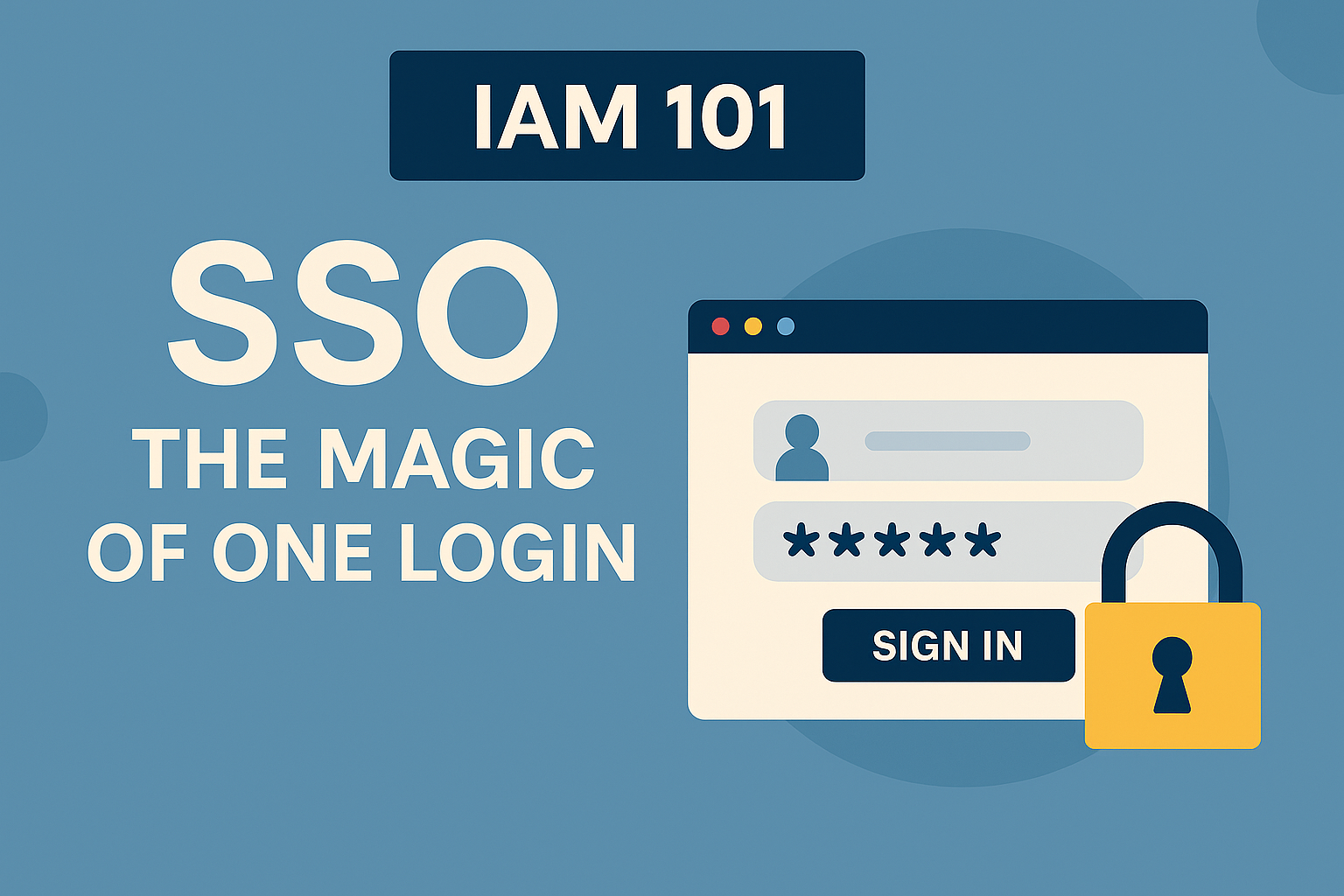
TL;DR
Single Sign-On (SSO) allows users to access multiple applications with just one login. It’s a cornerstone of modern IAM strategy—enhancing user experience, reducing password fatigue, and boosting productivity. But SSO done wrong can centralize risk. In this post, we cover:
- How SSO works (and where it fits)
- Benefits for security, UX, and operations
- SAML, OIDC, and modern federation protocols
- Common pitfalls and how to avoid them
🔍 Background
Back in the early 2010s, most companies I worked with had users juggling 5–10 logins daily. Each with a separate password. IT helpdesks were swamped with reset requests, and users either reused passwords or stored them insecurely.
That all changed with SSO.
Now, most enterprises use identity providers (IdPs) like Okta, Microsoft Entra ID, or Google Workspace to centralize login control. A user logs in once—often via MFA—and gains access to all their authorized apps without entering credentials again.
It’s efficient. It’s secure. And in 2025, it’s expected.
🔑 What is Single Sign-On?
Single Sign-On is an authentication process that allows a user to log in once to an identity provider and then access multiple systems without logging in again for each one.
SSO uses trust-based protocols (like SAML or OIDC) to delegate authentication. The app (called the “Service Provider”) trusts the identity provider’s assertion that the user is authenticated.
🧱 Common SSO Protocols
| Protocol | Description | Common Use |
|---|---|---|
| SAML 2.0 | XML-based, legacy but widely supported | Enterprise apps like Workday, Salesforce |
| OIDC (OpenID Connect) | JSON-based modern protocol on top of OAuth 2.0 | Cloud-native and mobile apps |
| CAS/Shibboleth | Academic federations, niche enterprise | Used in higher education, legacy IT |
Real Example:
- A user signs into Okta with MFA
- Okta issues a SAML token to Box.com
- Box verifies it and grants access—no additional login needed
🚀 Benefits of SSO
1. Better User Experience
No one enjoys managing 12 passwords. SSO means fewer logins and faster access to tools like Zoom, Slack, Jira, or Salesforce.
2. Reduced IT Overhead
Fewer password reset tickets. Centralized policy control. Faster provisioning and deprovisioning via groups or roles.
3. Stronger Security
Users aren’t tempted to reuse weak passwords. You can enforce MFA once at the IdP level, apply conditional access, and track all login events in one place.
4. Audit & Compliance
SSO centralizes login logs. During a compliance audit, you can show who accessed what—and when—with full traceability.
📉 Common Pitfalls of SSO
| Pitfall | Impact | Fix |
|---|---|---|
| No MFA on IdP | All apps are vulnerable if credentials are stolen | Enforce phishing-resistant MFA |
| Not revoking sessions | Former employees retain access to apps | Implement session lifetimes and deprovision flows |
| SSO bypass via local login | Legacy apps allow username/password | Disable password login at the app layer or enforce IdP only |
| Too much access granted | Overprovisioned users = lateral movement | Use least privilege and role-based assignment |
🔧 Building an Effective SSO Strategy
1. Pick the Right Identity Provider
Choose a platform that supports modern protocols, integrates with HR systems, and provides robust MFA options (e.g., Okta, Entra ID, PingOne).
2. Start with High-Risk Apps
Roll out SSO to email, finance, HR, and collaboration apps first. Prioritize systems that store sensitive data.
3. Enforce MFA at the IdP
Use FIDO2, push notification, or biometric MFA at login to eliminate reliance on SMS or weak 2FA.
4. Monitor and Audit
Log every login. Use behavioral analytics to detect anomalies like logins from new locations, devices, or IPs.
5. Educate Your Users
Let employees know what SSO does and how it protects them. Users are more likely to embrace MFA and IdP login flows when they understand the why.
🧠 SSO and Zero Trust
In a Zero Trust model, every access request must be validated—even after the initial login.
SSO fits perfectly here when combined with:
- Continuous Risk Assessment (via tools like CrowdStrike, Okta ThreatInsight)
- Session Context Validation (e.g., re-prompting for sensitive actions)
- Just-in-Time Access through federation and time-based permissions
📚 Cited Study
A 2023 report from Forrester Research found that organizations implementing SSO with enforced MFA saw 70% fewer credential-based breaches compared to those using siloed login systems.
🧭 Final Thoughts
Single Sign-On is one of those rare IAM tools that improves both security and productivity. But it must be implemented with care.
Don’t just think of SSO as convenience—it’s your central access gateway. Lock it down. Monitor it. And use it as a launchpad for broader Zero Trust adoption.
One login shouldn’t mean one point of failure—it should mean one point of control.
🚀 Up Next in the Series:
👉 IAM 101: Multi-Factor Authentication – Why MFA Still Matters in 2025